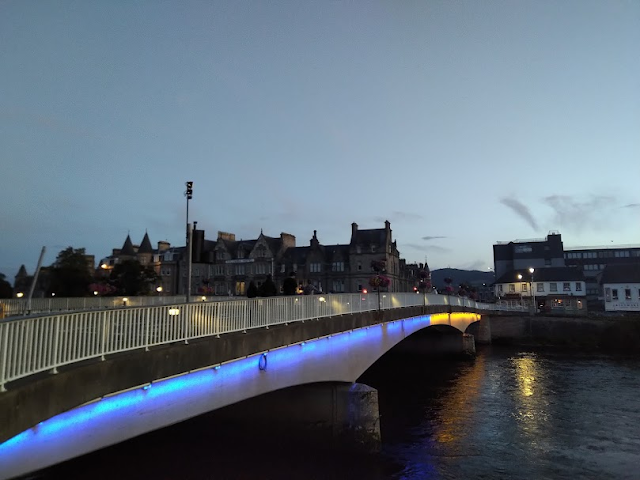My visit to insolent Inverness versus Elgin City...
Anyway, my first groundhopping adventure of 2025/2026 wouldn’t be complete without an element of farce courtesy of LNER, who still haven’t refunded me for the disaster that was my trip to Dingwall at the end of last season. “A faulty level crossing at Morpeth” meant my train arrived in Waverley the usual 20 minutes late, meaning I missed my 11.40 connection to Perth and subsequently Inverness and had to hang around, in the First Class lounge with a complimentary coffee and muffin for company, until the 1.30 service departed. It meant I arrived in Inverness at 5 and not half 3 as intended. No matter, it wasn’t the breathless race to the ground that Ross County v Livingston had been. On the plus side, I amazingly found my guest house without any hassle, suggesting my map reading is getting better. Well, it couldn’t get worse I suppose. After 10 minutes of invisibility at the entrance, I had an attempt at a freezing / scalding shower then, slightly refreshed, walked in the direction of the ground, though not in the nude in case you were wondering. Unlike the historic city centre, the Caledonian Stadium is a flat pack new build, reached by way of several industrial estates that border the River Ness and is snug beside the A82 on its way north to Wick and other such isolated places. It took me about 40 minutes to get there, keeping the water on my right at all times, so as to avoid getting lost. Surprisingly, there weren’t any midges around.
Other than The Prats, Inverness is probably only mentioned memorably in song as part of “The Ball of Kirriemuir,” so brilliantly updated by Aidan Moffat a few years ago. The four and twenty virgins in that song may well have been deflowered at the social event so memorably commemorated by that ballad, but I’d suggest it would be good for the similar number of teenage ultras and snare drums that make up the Inverness Casual Force, behind whom I was sat, if they get a chance to play Kirriemuir Thistle in the cup this year, with a post-match swally in the local Women’s Institute… You hear what I’m saying?
Being serious, Caledonian Stadium is not one you could fall in love with. Situated on the not so bonny banks of Loch Ness, it only has 3 sides, two of which are identikit flat pack stands, with one shut and the other a third full of about 200 hardy zealots from Elgin. I was in the main stand, which was comfortable enough, sold moderate Steak pies and warm Pepsi Max for an exorbitant price and looks like a scale model of Chelsea’s East Stand, with a menacing cantilever structure overhanging most of the pitch. The crowd was 1,296, including holidaying Americans and Germans, out for a bit of local culture and colour and the vast majority were more than happy with the 2-0 win for the home side, that could have been 6 or 7, were it not for profligate finishing and desperate defending, though Elgin hit the post with a long range screamer and missed a simple 1 on 1 late on. The two goals came just after the half hour from McKay and Longstaff (no, not that one and no, not his brother either). The first was an astute tap-in after a goalmouth scramble and the second a well timed effort after an impressive move down the left. Inverness are no great shakes (their centre backs were terrible), but Elgin looked more than a division below the hosts.
Come full time, the ICF packed up their flags, put their sweetie wrappers in the bin and filed out in an orderly fashion. I caught a single decker football special back to the City Centre, having already completed 15k steps in the day, then drank Tennents in a few pubs. One of whom had a bladdered folk singer on, who kept forgetting the words to “All Along the Watchtower,” to the extent that 2 riders were approaching for 3 verses in a row. Come the witching hour, I drank up and soon fell soundly asleep in my single bed after watching a BBC News Special about those clowns whose chainsaws left a sizeable Sycamore Gap.
Next
morning, I had breakfast at Tescos, courtesy of a couple of pretzels and
a big bottle of water, then caught the train at Inverness’s incredibly chaotic
station and snoozed to Waverley, changed, got the 75% empty LNER to Newcastle,
ran slap bang into former MP Ian Mearns at Monument, then got the bus home,
arriving the same time as if I’d been to work. Next week, it’s Inverness again,
only this time they’re away to newcomers East Kilbride. Once the cricket season
is over and Percy Main’s autumn schedule is confirmed, we’ll cast our minds
towards Stranraer, Peterhead and Queen’s Park again, now they are at Little
Hampden. The fun never stops round here, I’m telling you.





